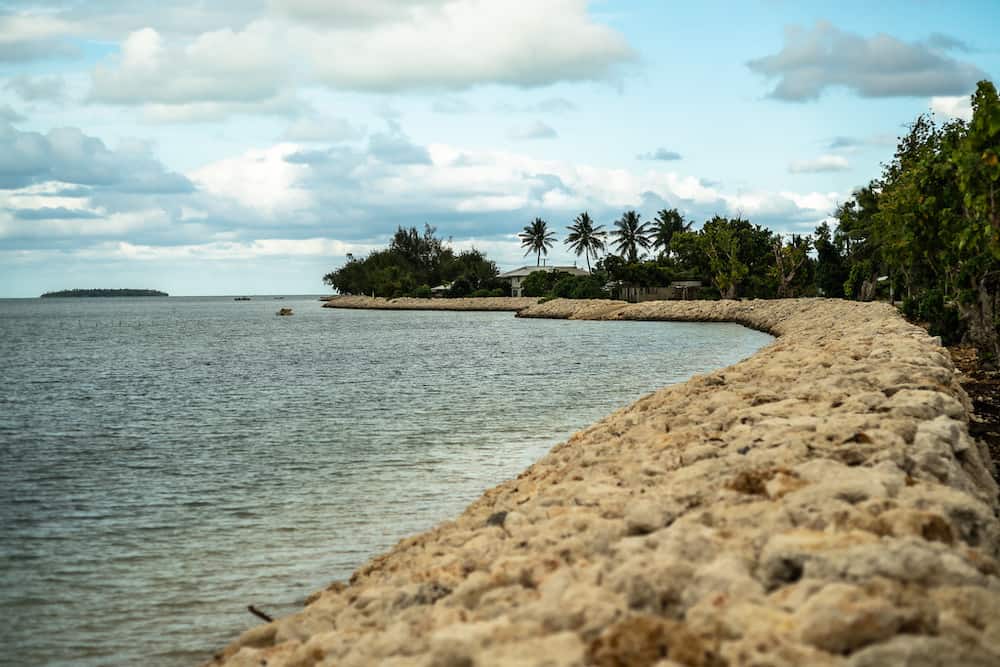
[Image above] The Climate Resilience Sector Project in Tonga includes the Hahake Coastal Protection program, which consists of hard and soft infrastructure interventions to protect the coastline and manage coastal erosion in selected sites on the Hahake (Eastern Tongatapu) coastline. Credit: Asian Development Bank, Flickr (CC BY-NC 2.0)
At the recent United Nations Climate Change Conference in Glasgow, Scotland, representatives from all over the world gathered to discuss how to address and mitigate the effects of climate change. However, there was a noticeable gap in representatives from one area expected to face the brunt of climate change effects—the Pacific Island region.
The Pacific Islands is a geographic region of the Pacific Ocean that comprises three ethnogeographic groupings—Melanesia, Micronesia, and Polynesia—but conventionally excludes the neighboring island continent of Australia and the Asia-related Indonesian, Philippine, and Japanese archipelagoes.

The three major ethnogeographic groupings in the Pacific Island region. Credit: Wikimedia
Pacific Island nations are among those most at risk from climate change as rising temperatures and water levels lead to worse tropical storms and nations potentially being swallowed up by the sea. Because of this immediate threat, the Pacific Island nations are not sitting idly by—many are emerging as frontrunners in the pursuit of renewable energy and sustainable infrastructure systems, building on abundant local and natural resources.
The Kingdom of Tonga is one Pacific Island nation that exemplifies the work being done in this region. Tonga is a Polynesian kingdom comprising more than 170 South Pacific islands, of which 36 are inhabited. It is the only remaining Indigenous monarchy in the Pacific Islands.
According to the UNU-EHS 2021 World Risk Report, Tonga is classified as the third most at-risk country in the world in terms of its exposure and susceptibility to natural hazards and the unfolding effects of climate change. (The Pacific Island nations of Vanuatu and the Solomon Islands rank first and second, respectively.)
In 2010, Tonga became the first country in the Pacific to develop and approve a Joint National Action Plan for the integration of climate change and disaster risk management. In the decade since, Tonga established several intersectoral programs to address disaster risk reduction and climate change adaptation and strengthen preparedness, response, and recovery efforts.
In October 2021, Tonga communicated its updated adaptation plan to the United Nations Framework Convention on Climate Change and launched an online Climate Change Portal to make this information accessible to the public. Learn more about what Tonga is doing to build its climate resilience in the video below.

Credit: Department of Climate Change Tonga, YouTube
As Tonga works to develop a more sustainable and resilient society, however, it is facing a new challenge—a sand shortage.
“Cyclones, king tides, and rising sea levels have increased the demand for resilient constructions and infrastructures, and therefore for sand. The building industry of Tonga has however exhausted the sand reserves in a country whose beaches have been destroyed by recent cyclones. Offshore mining has accelerated land erosion and destroyed the seabed of its main island, Tongatapu,” explains an article on the international newsite The Diplomat.
The Land (Removal of Sand) Regulations 1936 in Tonga requires a permit to be signed by the Minister of Land to dredge sand from Crown land or any other holding. However, the regulation has been difficult to enforce because of no viable alternative for sand.
Fortunately, a replacement for sand may soon be readily accessible thanks to the work of Viliami Lolohea. Lolohea is the First Secretary of the Tongan High Commission in London, and he has led the creation of a nongovernmental organization called Royal Lalanga Fononga (The Weaving of Our Journey) that will deliver ferronickel slag-based products to small island states.
Ferronickel slag is a by-product of nickel production that is used as an alternative to sand. It is considered a promising alternative in the production of green concrete for structural applications.
Lolohea became aware of slag’s potential to replace sand when he was working at the Department of Immigration in Nuku’alofa, the capital of Tonga. He attended the Advanced Security Cooperation course at the D.K. Inouye Asia-Pacific Center for Security Studies in Honolulu, and there a delegation from New Caledonia, a French territory in the South Pacific, called his attention to 25 million tons of nickel mining waste stockpiled outside Nouméa, the territory’s capital.
Last year, Royal Lalanga Fononga made its first order of 40 tons of ferronickel slag from New Caledonia, which will be used to produce bricks for houses in Tonga. The company hired to produce the slag bricks—MOT Enterprise of Ma’ufanga—has run into some delays due to difficulties importing cement and its increasing price. Despite these challenges, construction is expected to be completed by February under the direction of Maka Siale Construction. This month, on December 10, King Tupou VI and Queen Nanasipau’u of Tonga visited the building site to view the foundations of the slag-based concrete block house.
In an article on Matangi Tonga Online, Lolohea says Royal Lalanga Fononga is planning proposals to conduct feasibility studies for the use of slag in other projects, such as land reclamation, foreshores, and airports.
Author
Lisa McDonald
CTT Categories
- Construction
- Education
- Environment


